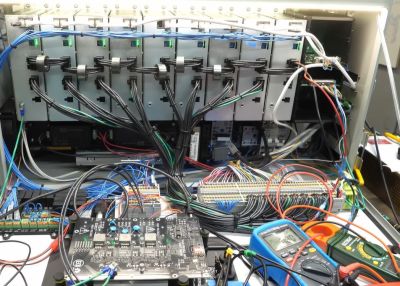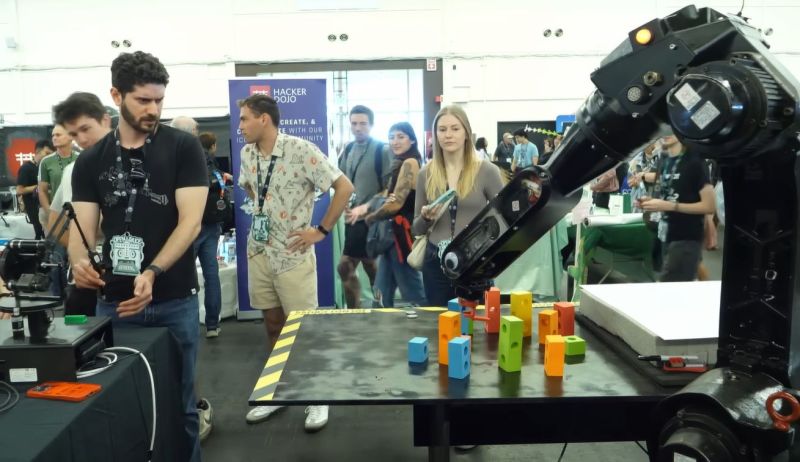
Industrial robots like robotic arms are basically everywhere, albeit usually out of the public’s eye in factories. This also means that they get replaced and scrapped all the time, making for many opportunities to snap up an industrial robot that once cost as much as a pretty fancy car for essentially peanuts. Over the years the bloke behind the [Excessive Overkill] YouTube channel did this a lot, which also revealed the main issue with these ‘cheap’ robots: the electronics and associated software, with the manufacturer rarely going out of their way to appease to hobbyists trying to fix up one of these units, never mind for free.
That said, if you’re persistent enough, you can reverse-engineer these beasts to the point where you can develop your own controller hardware and software solution. This is exactly what was done, resulting in an open source controller, found on the ExcessiveMotion GitHub page, that should allow you to control many of these industrial robots. At the core is a Zynq-7000 hybrid FPGA-ARM SoC chip, running real-time Linux (with preemptive scheduling patch) on the SoC side and custom HDL on the FPGA side to handle the hard real-time tasks.

The controller is made to be modular, with a backplane that can accept various interface cards in addition to the current RS-485 and RS-422 interfaces that are commonly used in industrial settings, such as here for controlling the individual servo drives of the robots. To make assembly and testing interesting, the first controller and integration with a robot was made ready for display at the Open Sauce 2025 event, requiring things to be rushed along, including reverse-engineering the servo protocol for a small-ish industrial robot suitable for public display and use, as well as developing the kinematics for the robotic arm.
With the controller now demonstrated, clearly this is the perfect time to rush out and get one of these fun industrial robots for a few hundred bucks. Currently the controller is still being finalized, with the author asking for feedback on what it should be able to support. If you have a particularly unusual industrial robot lounging around without the requisite controller, this might be your chance to revive it.
Thanks to [Hans] for the tip.
















What you say is bullshit there’s no cheap used robots in Tajikistan where I live. Keep us-centric stuff to minimum bro.
Its the sort of thing that might crop up on a bidding site now and again
Here in the UK for example
https://www.bidspotter.co.uk/en-gb/auction-catalogues/ncm/catalogue-id-ncm-au11257/lot-62c7ac66-aae9-434e-acc1-b36a011f9d35
https://www.ebay.co.uk/itm/267400447595
Although I’d admit 2K – 5K is kinda expensive, but something non functional without a control box might be cheaper
It’s not just USA. Here in the Netherlands I once went to a pretty big shop (JansenMachinehandel) that sells second had lathes & mills and they also had a little corner with industrial robots. They were thinking about scrapping them all, as there was very little interest for these things.
This was quite a lot of years ago. I just had a look at their website, and they don’t list any. But now there are some companies which are specialized in refurbishing old industrial robot arms to give them a second life.
I had to look up where Tajikistan is. Is there even any sort of industrialization in that country? You need a quite big industrial base and for a long time before old industrial robots become surplus. I guess there are plenty too in countries such as Japan, south Korea and Taiwan.
I think I saw a bunch of these things in the background when Ca Lem went shopping in a local machineshop. (He’s known for his excellent work on restoring a Schaublin 13 and other video’s). I think he’s from Vietnam, but I’m not sure.
I can understand that. My company scraped a robot arm a year ago and it was possible for me to take it at home. But I said no, because I realy did not see any project I can do with it outside of a factory. I understand that there is some fun in it, but the usability is close to zero.
Thanks for mentioning Ca Lem.
Never heard of him before.
Absolutely insane what this guy does.
https://youtu.be/DUSLAkFlWqg?si=-h485cqaCPm-glYU
When a robot arm that originally cost $40-60K can be picked up for $2-4k you can ship them to Tajikistan and still be considered cheap.
I can only assume that you are just trying troll. Funny to say the least.
Seriously, after reading the wikipedia entry on Tajikistan (which I had never heard of before), I doubt anyone there writes English or visits this site. So what’s your real problem?
Given that Tajikistan ranks 108th out of a field of 139 economies on the Global Innovation Index (https://www.wipo.int/gii-ranking/en/tajikistan), I don’t think the issue is that the article is US-centric.
Neat project, but seeing an old robot close (without control barriers) to people makes me jumpy – I’ve seen these go through cars, crush steel fabrications, and the generally destroy whatever’s in their oopsie point path.
Humans are squishy – even the modern ones won’t know they’ve shattered your chest until after the fact if it’s running anywhere close to the speed it’s meant to (and usually does) run at.
If you watch the video you’ll see that he put up some quite extensive safety including sensors that shut off power if a person goes past areas.
Sounds like a busness opertunity. If they are stiil working except for the contoller just update the controler. Of couse that assumes that you follow all saftey regulations and follow a good set of Code styles and rules like MISRA for C or F-35 for C++.
Well if you turn it into a gun, it would be exempt from safety regulations, so compliance is just a solenoid, a shotgun, and some hose clamps away.
When I was in art school, I had a proposal to get a robot arm and attaching a chainsaw to it and carve those chainsaw bear sculptures that you see at county fairs.
I thought it would strike a nice balance of ridiculous and terrifying.
Oh yes, this was going to be in a darkened gallery with the only light source being a spotlight attached to the arm itself.
Perhaps I will look into that again
The only terrifying part of a chainsaw on a robot arm is ‘art school’.
I’m all for it!
Darwin’s little helper!
Make it a strobe light!
Just stay out of the killzone
I absolutely love this project and that it will open up a world of DIY hacker robotics (not just arms, lots of industrial tech, like none functioning industrial CNC machines) but I also worry that if everyone knows about it the lots will start attracting more bids! Haha need to buy them all up before anyone knows they are no longer a dead end project. Massive respect to this guy for doing the very hard route and supporting 100% open source! Legend in the game
Is there a way to contact ExcessiveMotion / Excessibe Overkill?